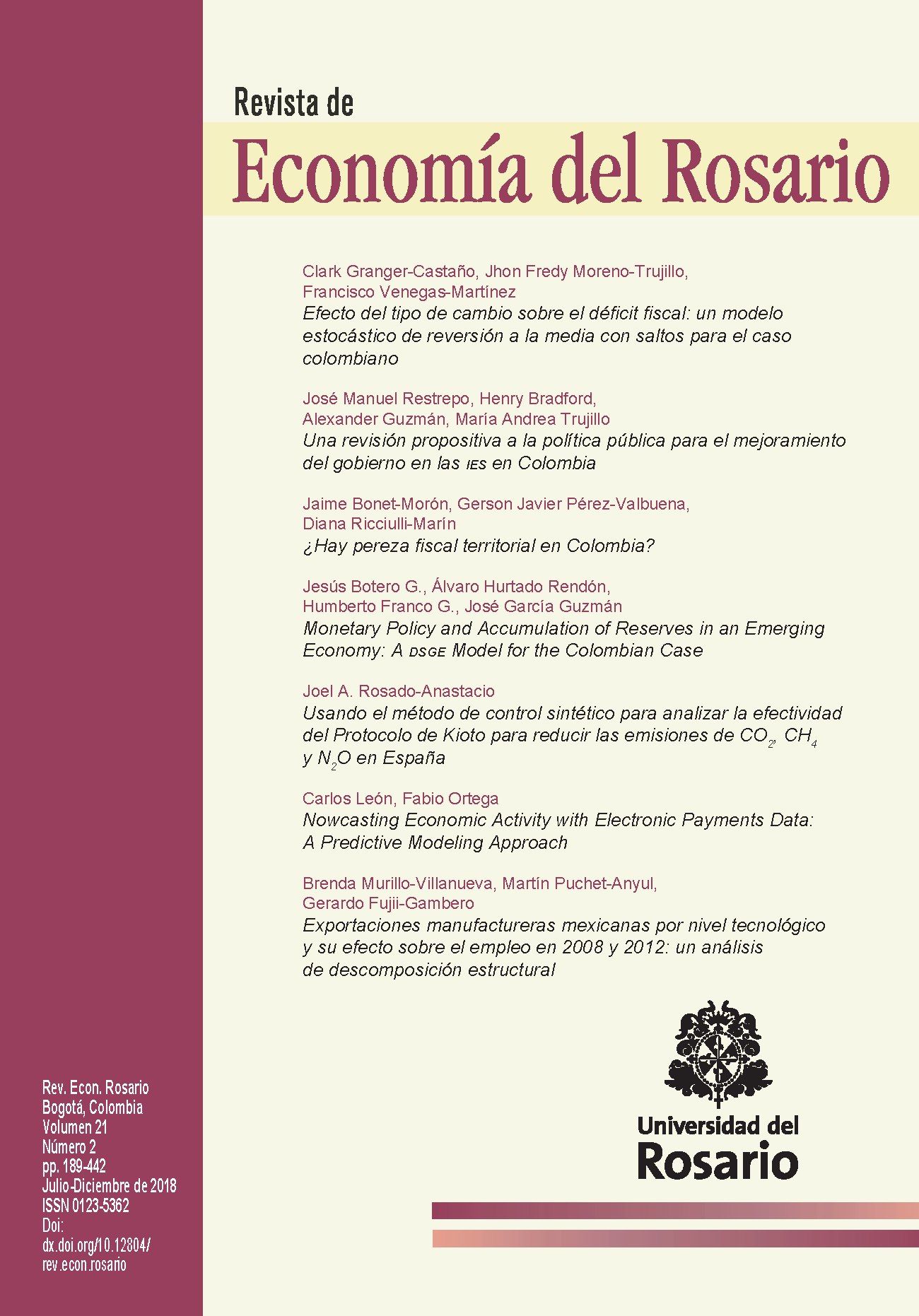Política monetaria y acumulación de reservas en una economía emergente: un modelo DSGE para el caso colombiano
Barra lateral del artículo
Contenido principal del artículo
Este artículo presenta un modelo de Equilibrio General Dinámico Estocástico (dsge) en el que se incluye explícitamente la demanda de dinero, las decisiones de inversión, el papel de los intermediarios financieros y el balance del Banco Central. El modelo permite la evaluación del impacto de diversos shocks exógenos sobre la actividad económica y los niveles de precios. También, permite evaluar diferentes formas de intervención del banco central en la economía, ya sea a través de la tasa de interés o mediante la acumulación de reservas internacionales. Se presta especial atención al parámetro básico de la función de utilidad de los hogares (aversión al riesgo, elasticidad de oferta laboral y demanda de dinero), a la formulación adecuada de los balances de los agentes económicos, y a la relación entre el balance del banco central y el suministro de dinero.
Descargas
Jesús Alonso Botero García
Professor and researcher of the Economic Department of University EAFIT. Integrant of the Economic and Firm Studies (GEE) research group of University EAFIT.
Álvaro Hurtado Rendón
Professor and researcher of the Economic Department of University EAFIT Integrant of the Economic and Firm Studies (GEE) research group of University EAFIT.
Humberto Franco González
Professor and researcher of the Economic Department of University EAFIT. Integrant of the Economic and Firm Studies (GEE) research group of University EAFIT.
José García Guzmán
Professor and researcher of the Economic Department of University EAFIT. Integrant of the Economic and Firm Studies (GEE) research group of University EAFIT.
Adrian, Tobias, & Liang Nellie (2016). Monetary Policy, Financial Conditions, and Financial Stability. Federal Reserve Bank of New York Staff Reports, March 2016.
Ahmed, W., Haider, A., & Iqbal, J., et al. (2012). Estimation of Discount Factor (beta) and coefficient of relative risk aversion (gamma) in selected countries. MRPA Paper, (39736).
Bernanke, B. S., Gertler, M., & Gilchrist, S. (1999). Chapter 21The financial accelerator in a quantitative business cycle framework, Handbook of Macroeconomics, Elsevier Volume 1, Part C, Pages: 1341-1393.
Blanchard, O. J., Romer, D., Spence, M., & Stiglitz, J. E. (2012). In the wake of the crisis: Leading economists reassess economic policy. Cambridge: mit Press.
Blinder, A. S. (2013). After the music stopped: The financial crisis, the response, and the work ahead. New York: Penguin Press.
Botero, J. A., & Rendón, N. (2015). Política monetaria convencional y no convencional: un modelo de equilibrio general dinámico estocástico para Colombia. Ensayos sobre Política Económica, 33(76):4-17.
Calvo, G. A. (1983). Staggered prices in a utility-maximizing framework. Journal of monetary Economics, 12(3):383-398.
Chari, V. V., Christiano, L. J., & Eichenbaum, M. (1995). Inside money, outside money and short-term interest rates. Technical report, National Bureau of Economic Research. Working Paper 5269.
Christensen, I., Dib, A., et al. (2006). Monetary policy in an estimated dsge model with a financial accelerator. Staff Working Papers 06-9, Bank of Canada.
Christiano, L. J., Eichenbaum, M., & Evans, C.L. (2005). Nominal rigidities and the dynamic effects of a shock to monetary policy. Journal of political Economy, 113(1):1-45.
Christiano, L.J., Motto, R., & Rostagno, M. (2010). Financial factors in economic fluctuations. Working Paper Series 1192, European Central Bank.
Dellas, H., Diba, B., & Loisel, O. (2010). Financial shocks and optimal policy. Working papers 277, Banque de France.
Eichengreen, B., Prasad, E., & Rajan, R. (2011). Rethinking central banking: Its time for an alternative framework. Rethinking Central Banking. Brookings Institution: Washington.
English, W. B., López-Salido, J.D., & Tetlow, R.J. (2015). The federal reserves’ framework for monetary policy: Recent changes and new questions. imf Economic Review, 63(1): 22-70.
Gerali, A., Neri, S., Sessa, L., & Signoretti, F.M. (2010). Credit and banking in a dsge model of the euro area. Journal of Money, Credit and Banking, 42(s1): 107-141.
Gertler, M., & Kiyotaki, N., et al. (2010). Financial intermediation and credit policy in business cycle analysis. Handbook of monetary economics, 3(3):547-599.
Hayashi, F. (1982). Tobin’s marginal q and average q: A neoclassical interpretation. Econometrica: Journal of the Econometric Society, 213-224.
Kydland, F.E., & Prescott, E.C. (1982). Time to build and aggregate fluctuations. Econometrica: Journal of the Econometric Society, 1345-1370.
Meh, C.A., & Moran, K. (2010). The role of bank capital in the propagation of shocks. Journal of Economic Dynamics and Control, 34(3):555–576.
Ostry, J.D. (2012). Managing capital flows: What tools to use? Asian Development Review, 29(1):82.
Reichling, F., & Whalen, C. (2012). Review of estimates of the Frisch elasticity of labor supply. Washington, DC: Congressional Budget Office.
Smets, F., & Wouters, R. (2003). An estimated dynamic stochastic general equilibrium model of the euro area. Journal of the European economic association, 1(5):1123–1175.
Smets, F.& Wouters, R. (2007). Shocks and frictions in us business cycles: A bayesian dsge approach. National Bank of Belgium Working Paper, (109).
Svensson, Lars E. O. (2018). Monetary Policy and Macroprudencial Policy: Different and separate? Stockholm School of Economics, march 2018.
Taylor, J.B. (1993). Discretion versus policy rules in practice. In Carnegie-Rochester conference series on public policy, volume39, pages 195–214. Elsevier.
Vargas, H., González, A., & Rodríguez, D. (2013). Foreign exchange intervention in Colombia. BIS Paper, (73h).
Walsh, C.E. (2010). Monetary theory and policy. Cambridge: mit Press.
Wapshott, N. (2013). Keynes vs. Hayek: el choque que definió la economía moderna. Barcelona: Ediciones Deusto.



